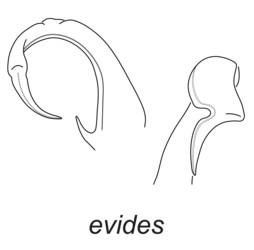Brachoria evides
The Silver City Mimic Millipede
Paul MarekCharacteristics
Brachoria evides individuals are about 42.1 mm long and 11.6 mm wide (females 44.1 mm X 11.8 mm). Color: 2-spotted pink (shown above); and 3 spotted yellow (both morphs have a faint purple metatergal stripe with white caudal border)


Brachoria evides genitalia - left male gonopodal acropodite (with setae removed): (Left) medial view and (Right) magnified apical view. © Paul Marek

Brachoria evides, 3-spotted yellow color morph. © Paul Marek
Habitat
Brachoria evides specimens were collected during the day (11:30) in a maple forested slope near a small stream. Individuals of the species were recorded from cedar woods (like B. cedra) in Greene County, Tennessee by Leslie Hubricht. No other xystodesmids were encountered sympatrically. Note: Individuals of B. evides may be confused in the field with B. mendota (whose range overlaps with B. evides, but was not found co-occurring).Distribution
Known only from the four sites in Hamblen, Hawkins, Jefferson and Greene counties in Tennessee. The closest known Brachoria species, B. mendota and B. hendrixsoni occur about 30 air km west and east of the center of B. evides distribution.Conservation status
Brachoria evides is threatened by habitat loss due to agriculture (especially growing demand for paper products), coal mining, development, and the invasion of exotic species.References
Marek P.E. 2010. A revision of the Appalachian millipede genus Brachoria Chamberlin, 1939 (Polydesmida: Xystodesmidae: Apheloriini). Zool. J. Linn. Soc. 159: 817-889.
Bollman CH. 1887. Descriptions of fourteen new species of North American myriapods. Proc. U.S. Nat. Mus. 10: 617-627.
Keeton WT. 1965. Descriptions of three new species of Brachoria, with notes on established species (Diplopoda, Polydesmida, Xystodesmidae). Proceedings of the Biological Society of Washington 78: 225-240.
Hoffman R.L. 1999. Checklist of the millipeds of North and Middle America. Virginia Museum of Natural History Special Publication. No. 8. Martinsville: Virginia Museum of Natural History.
Marek P.E., Bond J.E. 2006. Phylogenetic systematics of the colorful, cyanide-producing millipedes of Appalachia (Polydesmida, Xystodesmidae, Apheloriini) using a total evidence Bayesian approach. Mol. Phylogen. Evol. 41: 704-729.
Title Illustrations

| Scientific Name | Brachoria evides |
|---|---|
| Location | USA, Tennessee, Hamblen Co. |
| Reference | Marek P.E. 2010. A revision of the Appalachian millipede genus Brachoria Chamberlin, 1939 (Polydesmida: Xystodesmidae: Apheloriini). Zool. J. Linn. Soc. 159: 817-889. |
| Specimen Condition | Live Specimen |
| Sex | m |
| Life Cycle Stage | adult |
| View | dorsal |
| Collection | FMNH |
| Collector | Paul Marek |
| Image Use |
 This media file is licensed under the Creative Commons Attribution-NonCommercial License - Version 3.0. This media file is licensed under the Creative Commons Attribution-NonCommercial License - Version 3.0.
|
| Copyright |
© Paul Marek

|
About This Page
Work on the millipede Tree of Life pages was supported by a U.S. National Science Foundation Doctoral Dissertation Improvement Grant to Paul Marek and Jason Bond (DEB 0607996) and a Partnerships for Enhancing Expertise in Taxonomy Grant to Petra Sierwald, Jason Bond, and William Shear (DEB 0529715).
Paul Marek

Virginia Polytechnic Institute and State University
Correspondence regarding this page should be directed to Paul Marek at
brachoria@gmail.com
Page copyright © 2010 Paul Marek
 Page: Tree of Life
Brachoria evides . The Silver City Mimic Millipede.
Authored by
Paul Marek.
The TEXT of this page is licensed under the
Creative Commons Attribution License - Version 3.0. Note that images and other media
featured on this page are each governed by their own license, and they may or may not be available
for reuse. Click on an image or a media link to access the media data window, which provides the
relevant licensing information. For the general terms and conditions of ToL material reuse and
redistribution, please see the Tree of Life Copyright
Policies.
Page: Tree of Life
Brachoria evides . The Silver City Mimic Millipede.
Authored by
Paul Marek.
The TEXT of this page is licensed under the
Creative Commons Attribution License - Version 3.0. Note that images and other media
featured on this page are each governed by their own license, and they may or may not be available
for reuse. Click on an image or a media link to access the media data window, which provides the
relevant licensing information. For the general terms and conditions of ToL material reuse and
redistribution, please see the Tree of Life Copyright
Policies.
- First online 16 September 2010
- Content changed 01 October 2010
Citing this page:
Marek, Paul. 2010. Brachoria evides . The Silver City Mimic Millipede. Version 01 October 2010 (under construction). http://tolweb.org/Brachoria_evides/144217/2010.10.01 in The Tree of Life Web Project, http://tolweb.org/






 Go to quick links
Go to quick search
Go to navigation for this section of the ToL site
Go to detailed links for the ToL site
Go to quick links
Go to quick search
Go to navigation for this section of the ToL site
Go to detailed links for the ToL site